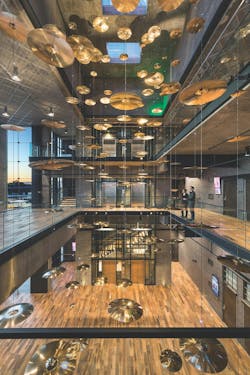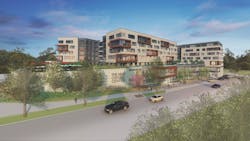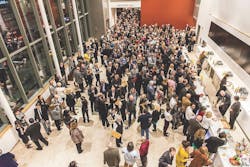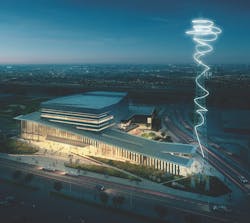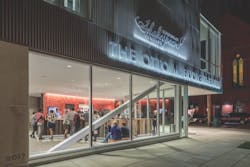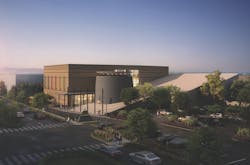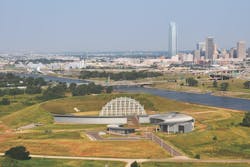Cultural centers: Community-based venues can be catalysts for downtown renewal
Columbia, Md., is a microcosm of what’s happening in cities across America, where cultural facilities—performing arts venues, libraries, museums, and other public spaces of congregation—are being positioned as integral to downtown renewal.
Columbia, a planned city originally developed by the Rouse Corporation in the 1960s, has approved the site plan for The New Cultural Center, a seven-story 570,000-sf building that its developer, Orchard Development, suggests could be the city’s next “community anchor.”
The $120 million project will encompass a performing arts center with a 350-seat dinner theater, two black-box theaters, dance rooms, and a full-service restaurant. A visual arts wing will house galleries, artist-in-residence studios, classrooms, and offices. The top five floors will offer 192 rental apartments (half of them affordably priced) and rooftop courtyards that conceal a 700-space parking garage.
Assuming the county comes through with the necessary bond financing, construction could get started next winter, says Scott Armiger, Orchard Development’s President. The New Cultural Center is planned for a 40-acre site at Symphony Woods, where the outdoor amphitheater Merriweather Post Pavilion has been undergoing a $55 million renovation.
Howard Hughes Corporation, which has controlled Columbia’s mixed-use Town Center since 2010, has approval for about 13 million sf of new downtown development that, according to Urban Land magazine, could add 5,500 market-rate residential units, 900 units of affordable housing, 4.3 million sf of offices, 1.3 million sf of retail, and 640 hotel rooms.
Similar efforts are under way in cities large and small. “Every great city has great cultural institutions,” says Jim Pepper Henry, CEO of the American Indian Cultural Center Foundation (AICCF), which is building the 130,000-sf American Indian Cultural Center & Museum in Oklahoma City to “tell the stories” of all 39 tribes in Oklahoma.
New cultural centers have sparked development in the form of new offices, restaurants, retail, hotels, business incubators, apartments, and arenas. In Lubbock, Texas, the 218,000-sf Buddy Holly Hall of Performing Arts & Sciences, which broke ground last June, has ignited a wildfire of redevelopment around it, 18 months in advance of its January 2020 scheduled opening. “We want this to be the center of Lubbock,” says Jack Diamond, Founder and Principal of Diamond Schmitt Architects, the center’s design architect.
“Every one of our cultural center clients has expectations of being a catalyst,” says Marcene Kinney, AIA, LEED AP, Director of Education and Arts for GBBN Architects, which recently completed the Otto M. Budig Theater for the Cincinnati Shakespeare Company.
Rocco Termini, CEO of Signature Development, Buffalo, N.Y., which has been an integral player in numerous renovation projects in that city, believes the planned conversion of an abandoned library in North Buffalo, built in 1923, into a 4,000-sf Italian Cultural Center will encourage other development—“especially in this case, where the building had been vacant for 10 years.”
But cities need to be careful about overselling the potential rewards from investing in cultural centers, warns Joanna Woronkowicz, Assistant Professor, School of Public & Environmental Affairs, Indiana University. She is co-author of “Cultural Organizations: Building Arts Facilities in U.S. Communities,” which examined the economic impact of cultural centers built between 1994 and 2008.
Woronkowicz says the research didn’t find much evidence that cultural center investment translates substantively into more jobs, higher wages, or new business opportunities. (The researchers did not track whether such investments led to more construction or redevelopment.)
Done right, she concedes, cultural centers can benefit their communities. She points to the $48 million Durham (N.C.) Performing Arts Center, which opened in November 2008, where the developers partnered with Nederlander Organization and Professional Facilities Management to stage 100 to 200 performances a year. A portion of the center’s net income flows to the city’s coffers.
In the following pages we take a closer look at cultural centers to see how they are helping to enliven their communities and catalyze new development.
PERFORMANCE VENUES PUMP LIFE BACK INTO MORIBUND DOWNTOWNS
Perhaps no other culturally oriented building type can impact a city’s economy as reliably as a performing arts center, according to designers, developers, and government officials.
Exhibit A is St. Catharines, Ont., whose downtown “had no life” before the opening, in 2015, of the First Ontario Performing Arts Center, says Executive Director Steve Solski. The 95,000-sf facility, which the city developed in collaboration with Brock University, has a 775-seat concert hall, 300-seat recital hall, 210-seat dance theater, and 187-seat movie theatre. Open 356 days a year, the center hosts 900 events that draw 120,000 people a year—almost equaling the city’s population (133,000). “All of a sudden, there are people downtown all the time,” says Solski.
The city has issued Can$200 million in building permits for downtown projects in the last two years, and has been widening sidewalks so downtown restaurants can set up outdoor cafés. High-rise residential is coming to downtown too, says Solski.
Sparking economic growth was the last thing the Cincinnati Shakespeare Company (CSC) was thinking of when it was scoping possible sites for its 20,000-sf Otto M. Budig Theater. The group was much more focused on finding a location with immediate audience appeal, says GBBN’s Kinney. The acting company, which had been operating out of an old 160-seat movie theater, decided to build within the city’s cultural corridor near Washington Park and the civic center—an area served by new light-rail service.
See Also: Risorgimento, Buffalo style
Even though “growth” was not the top priority, says Kinney, cultural centers like the Budig have a way of benefiting communities “in a soft way.” The new 250-seat theater “is already established as a cultural core of the city.” In its first season (August 2017 through March 2018), CSC hosted 75 events for neighborhood and community groups. The overwhelming majority (90%) of local merchants and owners polled by CSC said the theater has had a positive impact on the neighborhood. Patrons spent an estimated $1.5 million on dining and parking that first season, 55% of which took place in the adjacent Over-the-Rhine neighborhood.
“It’s sometimes hard to put metrics on economic impact,” says Steven Kenat, AIA, LEED AP BD+C, NCARB, GBBN’s Director of Community Development. “But it’s almost always easy to prove that these kinds of buildings work.”
Michael Fischer, Associate Principal for Rockwell Group, thinks that programming is always going to determine whether a cultural center becomes a genuine urban hub. “How do you activate the area beyond the eight o’clock performance?” he asks.
Rockwell Group was the design architect for Anthem, a 57,000-sf concert venue that’s one of the entertainment components of The Wharf, the biggest redevelopment in Washington, D.C.’s, history.
Anthem, which opened October 12, is embedded between two mixed-use towers with 501 rental units. (Perkins Eastman, Anthem’s AOR, was design architect on the towers.) During performances the sound level inside Anthem can reach 120 decibels.
To minimize sound leaking out of the concert hall into the apartments, the project team—which included acoustical consultant Akustiks, the venue’s operator IMP, and GC Clark Construction—created a “box-within-a-box” solution that places acoustical isolation joints between concrete slabs. “You can model this on a computer, but you never know if it’s going to work until you’ve tested it for real,” says Fischer. Of the project’s $60 million cost, $3 million, or 5%, went toward soundproofing alone.
Because Anthem is a flat-floor, general admission venue, it can also be used for product launches, trade shows, and political and corporate events. Even the venue’s 40-foot-wide lobby is rentable, says Fischer.
Anthem “sends a message about The Wharf as the new urban ‘thing’ in D.C.,” says Fischer.
‘Hub city’ finds its center
A new performing arts hall under construction in Lubbock, Texas, is kicking downtown redevelopment into overdrive.
The Lubbock Entertainment and Performing Arts Association (LEPAA) was created in 2013 to raise funds for the construction of a performing arts center that would reinvigorate this city of 250,000. Four years later, the group broke ground on the Buddy Holly Hall of Performing Arts and Sciences, a $155 million, 218,000-sf facility with two theaters, a 22,000-sf dance center for Ballet Lubbock, a 100-seat restaurant called Bistro, and a 6,000-sf multipurpose room that can accommodate receptions, banquets, lectures, meetings, and rehearsals.
The association’s aspirations extended beyond Buddy Holly Hall, which is scheduled to open in early 2020. “They really are seeking to strengthen the community around the place,” says Matthew Lella, OAA, MRAIC, Principal with Diamond Schmitt Architects, this project’s design architect.
Lubbock nearly had its downtown blown off the map by a tornado that swept in on May 11, 1970. For decades after, Lubbock remained a sleepy town with little to offer residents or businesses. “The redevelopment of Lubbock’s downtown was just a dream in 2003,” recalls Rob Allison, LEPAA’s Executive Director, who spent 22 years as Assistant City Manager for Development Services.
But by 2008, the dream started becoming a reality when the city council approved a redevelopment action plan that, says Allison, placed the performing arts center at its core and divided the downtown into five districts, all within walking distance of each other, and one that would be for “high-intensity residential” development.
At one point Buddy Holly Hall was budgeted for only $85 million and was expected to lose $950,000 annually, which would have required a $30 million endowment to keep it afloat. “But then, the school system, which was looking to build its own multipurpose center, became a partner,” recalls Allison. “Ballet Lubbock, which was looking to build its own dance academy, became a partner. And United Market Street signed on as our food-service operator.”
The association decided to bump up the budget in order to expand the scope of the building’s programming, and Buddy Holly Hall is now projected to operate in the black.
“It was our belief that as the PAC and other buildings opened, the services would follow,” says Tim Collins, LEPAA’s Chairman.
Marc McDougal, CEO of McDougal Construction, Lubbock’s leading contractor, says the performing arts center “absolutely” has been a catalyst for downtown development. Among the recent projects McDougal’s firm has worked on is The West Table, an upscale restaurant, and the conversion of seven floors of a downtown hotel to high-end residential.
Soon after the center was given the go-ahead, Valencia Group, a Houston-based hotel management firm, purchased land for the construction of a 165-key hotel. Tulsa, Okla.-based WestMark Leasing renovated Lubbock’s old post office/federal courthouse for 23 loft apartments.
The city is renovating the Omni Building—“an eyesore for years,” says McDougal—to government office space, and has allocated $50 million to renovate the old Citizens Tower building for a new city hall. There are also plans for a downtown convention center and hotel that would be attached to an existing civic center across the street from the PAC.
Allison says that another $250 million in new construction for downtown Lubbock, including mixed-use residential and hotels, “could be announced within the next 18 to 24 months.”
Few local businesspeople are as committed to Lubbock’s future as Bart Reagor, Co-owner and CEO of Reagor-Dykes Auto Group, one of the country’s top auto dealers.
Over the past decade or so, Reagor has been an investor in the purchase of 13 downtown buildings, including the 22,575-sf Levine’s department store, which is being converted to Shops on Broadway for retail and restaurants. The old 9,100-sf Anderson Brothers jewelry store has been renovated and now serves as Reagor-Dykes’s ecommerce hub. The 45,000-sf Green Building houses Reagor-Dykes’ corporate headquarters as well as a 400-seat event space, an Italian restaurant, and offices for the Make-A-Wish Foundation.
Reagor concedes that some of Lubbock’s redevelopment might have happened without the PAC. “But not all of it, by a long shot. When you have $150 million committed to a performing arts center, that wakes people up.”
MUSEUMS LIKE COMPANY
More cities now organize their cultural buildings in districts. In Pompano Beach, Fla., the new Library and Cultural Center is within walking distance of the 38-acre Innovation District, whose first new-construction project, City Vista, includes 111 apartments and 3,800 sf of ground-floor commercial space, some of which is available for coworking tenants. According to the South Florida Business Journal, the Innovation District’s zoning would allow for 750,000 sf of office space, 165,000 sf of retail, 35,000 sf of restaurants, 1,500 residential units, and two hotels with a total of 420 rooms.
The Library and Cultural Center is clustered with two other cultural facilities: Bailey Contemporary Arts, at one time a falling-down hotel before the city’s Community Redevelopment Agency paid $1 million to buy the building and $1.4 million to renovate it (it opened in 2014); and the Ali Cultural Arts Building, which once seemed destined for demolition but has been resurrected as an African-American performance space.
The “cultural” portion of the new Library and Cultural Center has been operating since May 2017. In addition to an art gallery and multimedia digital center, the cultural center features a 5,000-sf flex space that can be leased for occasions like corporate events and wine tastings. Last January, the 27,000-sf library portion of the center debuted. It features an electronic media lab with computers and Wi-Fi connectivity, plus a Teen Tech Studio.
While the city’s Economic Development office hasn’t assessed the economic impact of this 47,000-sf, $19.8 million dual-use facility, “there’s certainly hope” that it will become a catalyst for future development, says Michael Tipton, the center’s Director. Already, some restaurants and retail have opened in Old Town Pompano, which “was pretty dilapidated before,” he says.
The $11 million renovation and expansion of the 102-year-old Maryland Theatre is one of eight “catalyst” projects proposed for Hagerstown, Md., a city that has “beautiful architecture but a lot of empty buildings,” says Sue Hains, AIA, LEED AP, Vice President and Principal with Grimm + Parker Architects, the project’s design architect. Another is a Cultural Arts Trail that connects the downtown Arts & Entertainment district with Hagerstown’s city park and the Washington County Museum of Fine Arts.
Houston’s Museum District consists of 19 buildings, notably the three-story Holocaust Museum Houston, which is undergoing a $33.8 million renovation that will more than double its size, to 56,499 sf from 21,800 sf. When completed next April, the renovation will expand the museum’s library and add a new performance hall and gallery. A World War II–era German rail car and a Danish rescue boat will be dropped into the museum as exhibits.
CEO Kelly Zuñiga says the institution, which opened in 1996, plays an important role for Houston’s Jewish community, which numbers about 50,000, and for the 46,000 students from a 100-mile radius who visit it each year.
Except for a grant from the Department of Homeland Security, the Holocaust Museum’s renovation is being privately funded. The project is among the $800 million in upgrades and expansions in Houston’s Museum District, whose institutions receive 6.5 million visitors annually and are responsible for $372 million in annual economic impact for the city, according to Julie Farr, Executive Director of the Houston Museum District Association.
Part of the district falls within Hermann Park and is served by four stops on the city’s METRORail light rail system. Restaurants have opened, and a bike-share program is now operating. The nine-square-mile Museum Park neighborhood, which a decade ago had little residential development, continues to add apartments and attract residents. “The district is a force for our city’s vitality,” says Farr.
PRESERVING TRIBAL CULTURES
American Indian tribes have been active in building cultural facilities that serve their communities and keep their histories alive.
In January, the 57,000-sf Ho-Chunk Nation Community Center opened in Black River Falls, Wis. The $16 million project offers daycare services, Native language training, job search tools, a fitness center with a running track, a full-size basketball court, and classrooms.
“This is truly a community center,” says David Keating, Project Manager for general contractor Miron Construction. The tribe also runs the nearby Ho-Chunk Casino, which recently expanded and added a 123-key hotel.
The Shawnee Tribe spent more than $2 million on its new Heritage Center in northwest Oklahoma City. The Heritage Center, which was scheduled to open last month, was designed and built by FSB Architects + Engineers. It will be “a place for our people to tell our story, not only to other Native Americans but to the larger population,” says Ben Barnes, the tribe’s Second Chief and Vice President.
The American Indian Cultural Center and Museum is being constructed on 200 acres that once was Oklahoma City’s Oil Field No. 1. “This project is a catalyst for reclaiming the land,” says the AICCF’s Jim Pepper Henry.
Construction began in 2006 but was suspended when the state slashed its budget. Three years ago the Oklahoma Legislature agreed to restart construction with state, private, and tribal funding. Henry says the shell of the building has been built, but another $65 million is needed to complete the construction.
The building, located at the intersection of three highways in Oklahoma City, will have an intergenerational discovery component and 7,000 sf of space for exhibits from other cultures.
Henry cites a recent study Oxford Economics did for the American Alliance of Museums, which estimates that museums in Oklahoma generate $404 million a year in economic impact and $92 million in annual tax revenue and $292 million in wages and salaries.
